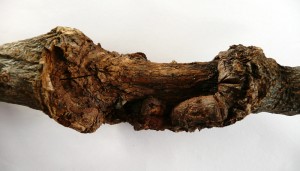Woody stem symptoms
Many different plant problems cause symptoms to appear on woody stems. Below are a some of the terms used to describe these symptoms and descriptions of what they mean:
Canker
This term is used generically to refer to any death of stem tissues within a limited area, which leads to a lesion (a wound or sunken area) and cracks appearing in the stem. Canker occurs due to the cambium within the stem being killed and therefore creating an area where no new tissues (ie bark) can grow. Sometimes the lesion will heal, but often it persists from year to year. Most cankers are caused by bacterial or fungal infections, although some viruses or frost damage may cause canker symptoms.
Cankers can provide entry points for other organisms, such as wood-decay fungi, causing further damage to be done.
While generally relating to woody stems, the term canker is also used in reference to fruit/root rotting diseases (such as parsnip canker).
Die-back
This refers to the death of entire stems. It can be caused by several different factors:
- A canker girdling the circumference of a stem, causing the tissue above the canker to die (as it cannot be supplied with food and nutrients from the plant’s roots).
- Fungal infections or other pathogens can cause stems to die from the tip downwards.
- Problems in the rooting area (due to, for example, drought, nutrient deficiencies, water-logging or root rot) may lead to die back of stems (or entire plants).
- Cold temperatures or winds can cause tips of stems to die back.
- Pests boring into the stem can cause die-back above their point of entry.
Blight
Usually referred to as stem or twig blight, the term ‘blight’ is used rather vaguely in relation to any sudden death of small stems or twigs. This could be caused by, for example, bacterial infection or a very small canker girdling the stem/twig.




